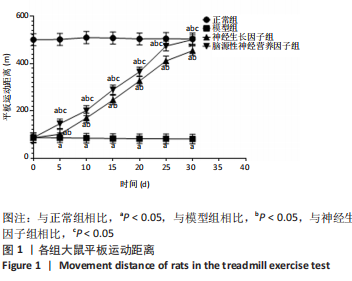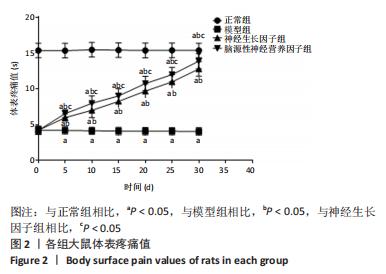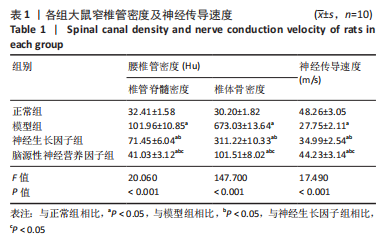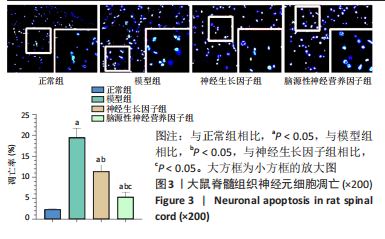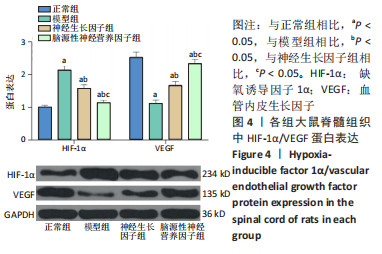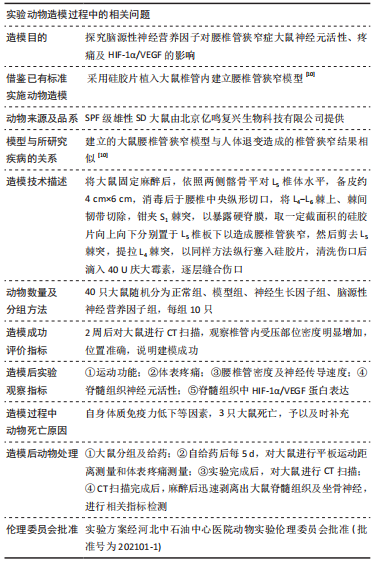中国组织工程研究 ›› 2023, Vol. 27 ›› Issue (26): 4120-4125.doi: 10.12307/2023.450
• 血管组织构建 vascular tissue construction • 上一篇 下一篇
脑源性神经营养因子干预腰椎管狭窄症大鼠神经元活性、疼痛及相关因子的变化
安河朋,刘振腾,李立新,许雅芳,樊国峰
- 河北中石油中心医院骨科,河北省廊坊市 065000
Effects of brain-derived neurotrophic factor on neuronal activity, pain, and related cytokines in rats with lumbar spinal stenosis
An Hepeng, Liu Zhenteng, Li Lixin, Xu Yafang, Fan Guofeng
- Department of Orthopedics, Hebei Central Hospital of Petro China, Langfang 065000, Hebei Province, China
摘要:
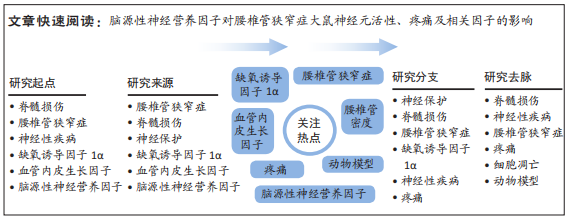
文题释义:
缺氧诱导因子1α(hypoxia-inducible factor-1α,HIF-1α):是一种转录因子,主要在缺氧条件下表达,其可激活多种因子的转录,从而提高组织和细胞对缺血、缺氧环境的适应。而有研究表明,脊髓创伤后继发性病理损害常引起脊髓组织缺血、缺氧,故可推测缺氧诱导因子1α可能与腰椎管狭窄症的发生、发展密切相关。脑源性神经营养因子(brain-derived neurotrophic factor,BDNF):作为神经营养因子家族的重要成员,在神经保护、促进突触生长等方面发挥着重要作用,且目前已有研究报道其在治疗脊髓损伤等神经性疾病的研究中,对周围神经的作用取得了一定的成果,具有较好的临床疗效。
背景:研究发现,脑源性神经营养因子缺失会导致中枢运动结构的神经退行性病变,从而导致多种运动神经疾病的发生,而腰椎管狭窄症作为慢性进行性神经功能障碍症候群,脑源性神经营养因子可能成为治疗该病的有效靶点。
目的:探究脑源性神经营养因子对腰椎管狭窄症大鼠神经元活性、疼痛及缺氧诱导因子1α/血管内皮生长因子的影响。
方法:选取40只SPF级SD雄性大鼠,随机取30只建立腰椎管狭窄模型,剩余10只为正常组。建模成功后将大鼠随机分为模型组、神经生长因子组及脑源性神经营养因子组。神经生长因子组大鼠腹腔注射1 500 U的神经生长因子,脑源性神经营养因子组大鼠鞘内注射20 μL 10 mg/L的脑源性神经营养因子,均1次/d,持续30 d;正常组、模型组同期灌胃同体积生理盐水。给药结束后,观察并记录大鼠运动功能及体表疼痛情况,CT检测腰椎管密度,神经干动作点位传导速度测定仪检测大鼠神经传导速度,TUNEL法检测脊髓组织神经元活性,免疫印迹法检测缺氧诱导因子1α/血管内皮生长因子蛋白表达。
结果与结论:①与正常组比较,模型组大鼠平板运动距离、体表疼痛值、神经传导速度均明显降低(P < 0.05);与模型组比较,神经生长因子组、脑源性神经营养因子组大鼠上述3项指标均明显升高(P < 0.05),脑源性神经营养因子组较神经生长因子组升高显著(P < 0.05);②与正常组比较,模型组大鼠腰椎管密度、脊髓组织神经元细胞凋亡率显著升高(P < 0.05),与模型组比较,神经生长因子组、脑源性神经营养因子组大鼠腰椎管密度、神经元细胞凋亡率明显降低(P < 0.05),且脑源性神经营养因子组比神经生长因子组降低显著(P < 0.05);③与正常组比较,模型组大鼠脊髓组织中缺氧诱导因子1α蛋白表达明显升高(P < 0.05),血管内皮生长因子显著降低(P < 0.05),与模型组比较,神经生长因子组、脑源性神经营养因子组大鼠缺氧诱导因子1α蛋白表达均明显降低(P < 0.05),血管内皮生长因子显著升高(P < 0.05),且脑源性神经营养因子组比神经生长因子组变化明显(P < 0.05);④结果说明,脑源性神经营养因子对腰椎管狭窄症大鼠具有显著疗效,可改善其神经元活性,降低疼痛,这与抑制缺氧诱导因子1α表达、促进血管内皮生长因子表达相关。
https://orcid.org/0000-0003-0020-3345(安河朋)
中国组织工程研究杂志出版内容重点:组织构建;骨细胞;软骨细胞;细胞培养;成纤维细胞;血管内皮细胞;骨质疏松;组织工程
中图分类号:
